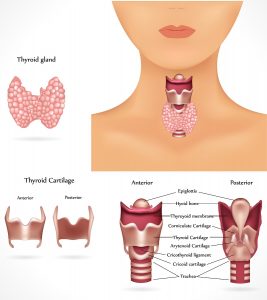Background
Hypothyroidism results from lack of sufficient thyroid hormone being produced by the thyroid gland. Older adults may have subclinical hypothyroidism, in which the TSH (thyroid-stimulating hormone) is elevated and the T4 (thyroxine or thyroid hormone) is normal; 4.3–9.5% of the general population has this problem (Woolever & Beutler, 2007). In this condition, the body is trying to stimulate production of more thyroid hormone. Some older adults with this condition will progress to have primary or overt hypothyroidism. This is when the TSH is elevated and T4 is decreased. Hashimoto’s disease is the most common cause and represents 90% of all patients with hypothyroidism (American Association of Clinical Endocrinologists [AACE], 2005; Woolever & Beutler, 2007), though certain pituitary disorders, medications, and other hormonal imbalances may be causal factors.
Warning Signs
Older adults may present an atypical picture, but the most common presenting complaints are fatigue and weakness.
Diagnosis
Diagnosis should include a thorough history and physical. Bradycardia and heart failure are often associated factors. Lab tests should include thyroid and thyroid antibody levels (common to Hashimoto’s), and lipids, because hyperlipidemia is also associated with this disorder.
Treatment
Treatment centers on returning the thyroid ¬hormone level to normal. This is done through oral thyroid replacement medication, usually L-thyroxine. In older adults with coexisting cardiovascular disease, starting with the usual doses may exacerbate angina and worsen the underlying heart disease, so it is important to start low and go slow. Titration should be done cautiously, with close monitoring of the older adult’s response to the medication. The does should be adjusted on 6- week intervals until normal levels of thyroid hormone are achieved. Once the TSH is within normal limits, then checking the TSH should be done every 6 to 12 months to monitor effectiveness and blood levels, because hyperthyroidism is a side effect of this therapy and can have serious implications on the older person’s health.
Patients need to learn the importance of taking thyroid medication at the same time each day without missing doses. Sometimes older adults have other problems associated with hypothyroidism, such as bowel dysfunction and depression. Any signs of complicating factors should be reported to the physician, and doctors’ appointments for monitoring should be religiously kept. Strategies for managing fatigue and weakness should also be addressed, because some lifestyle modifications may need to be made as treatment is initiated.
Adapted from Mauk, K. L., Hanson, P., & Hain, D. (2014). Review of the management of common illnesses, diseases, or health conditions. In K. L.
Mauk’s (Ed.) Gerontological Nursing: Competencies for Care. Sudbury, MA: Jones and Bartlett Publishers. Used with permission.
http://www.nlm.nih.gov/medlineplus/ency/article/000353.htm

